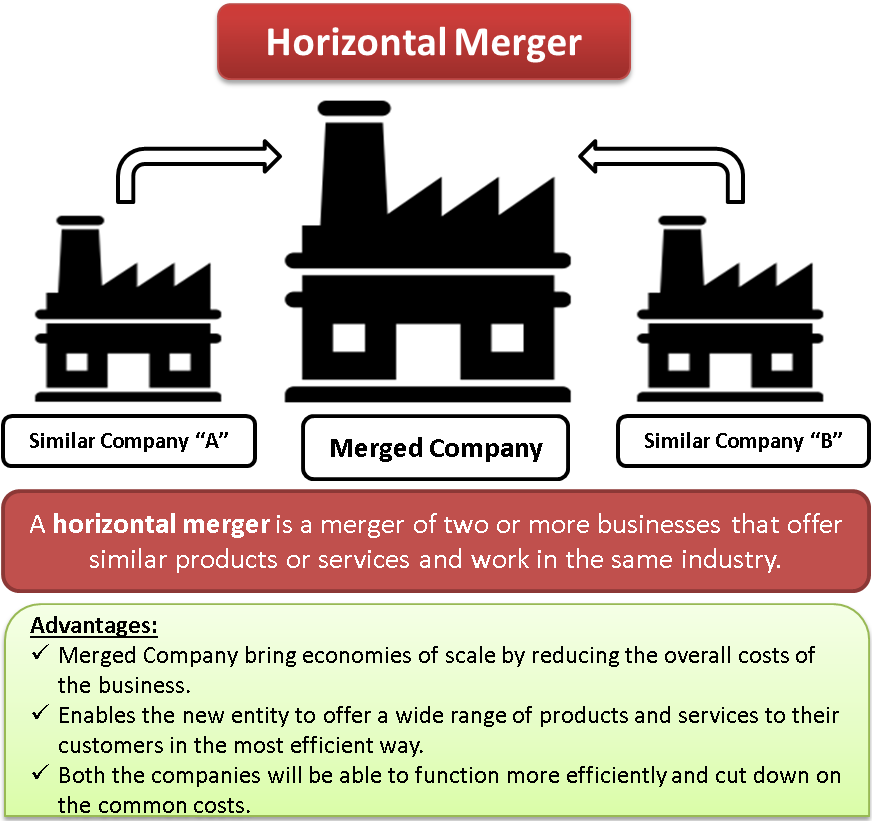What is a Horizontal Merger?
A horizontal merger involves a merger between two or more businesses that offer similar products or services and work in the same industry. In this merger, one entity buys another entity that is its competitor to form a new combined entity. Such a merger is done with the intent to gain higher synergies and capture greater market share.
Economics Definition of Horizontal Merger
As per the economic definition on MBDA.Gov, “Horizontal merger is a business consolidation that occurs between firms who operate in the same space, often as competitors offering the same good or service.” There are many types of mergers.
Why Companies Go for Horizontal Mergers?
Businesses opt for such mergers due to the growing competition. When two or more entities in the same line of business merge, they bring economies of scale by reducing the business’s overall costs. The horizontal merger enables the new entity to offer a wide range of products and services to its customers in the most efficient way. It allows them to diversify their business, enter new potential markets, and cover a bigger market share. The business also gets access to more resources than it had before the merger. There are many other benefits of mergers and these include:
- Market consolidation
- Diversification
- Synergy
- Strategic positioning
- Eliminating competition
- Achieving economies of scale
- Reducing costs
- Increasing market share
- Expanding product/service offerings
- Broadening customer base
- Increasing revenue streams
- Improving efficiency & effectiveness
- Enhancing product/service quality
- Increasing innovation

Horizontal Merger Example
Let us take a hypothetical example to understand the concept. If Pepsi and Coca-Cola merge, it would be termed as a horizontal merger. Both companies produce a similar type of product and cater to the same customer group. As a result of the merger, both companies will be able to function more efficiently. And cut down on the common costs, bringing economies of scale.
Also Read: Vertical Merger
Real-life Examples of Horizontal Mergers
The following are some real-life examples of horizontal mergers:
American Airlines and US Airways
In 2013, American Airlines merged with US Airways to become the largest airline in the world.
Exxon and Mobil
In 1999, Exxon and Mobil, two of the largest oil companies in the world, merged to create ExxonMobil.
HP and Compaq
In 2002, Hewlett-Packard (HP) acquired Compaq, a computer and technology company.
These are some real-life examples of a horizontal merger, as each pair of companies operates in the same industry and produced similar products or provides similar services.
Horizontal vs Vertical Merger
Horizontal mergers and vertical mergers are two different concepts altogether. A horizontal merger is the merger of two or more businesses in the same industry that produces similar goods or services. On the other hand, a vertical merger is the merging of two or more businesses that produce different goods or services. The vertical merger takes place among firms that operate in the same industry but at different levels of the supply chain.
Read more at Horizontal vs. Vertical Integration.
Horizontal vs. Joint Venture
A joint venture is a business arrangement between two or more businesses to achieve a specific task. Once the task is accomplished, the joint venture ceases to exist. On the other hand, a horizontal merger consists of a merger of two or more companies in the same industry, producing similar goods or services. It aims to reduce the competition in the marketplace by creating a monopoly for the business.
Conclusion
Businesses are facing tough times due to ever-growing competition. Their synergy costs are increasing, and margins are declining. A horizontal merger is a solution for the business to overcome this problem. When two entities in the same industry that is producing similar goods or services merge together, it brings efficiency in operations and a decline in costs.

